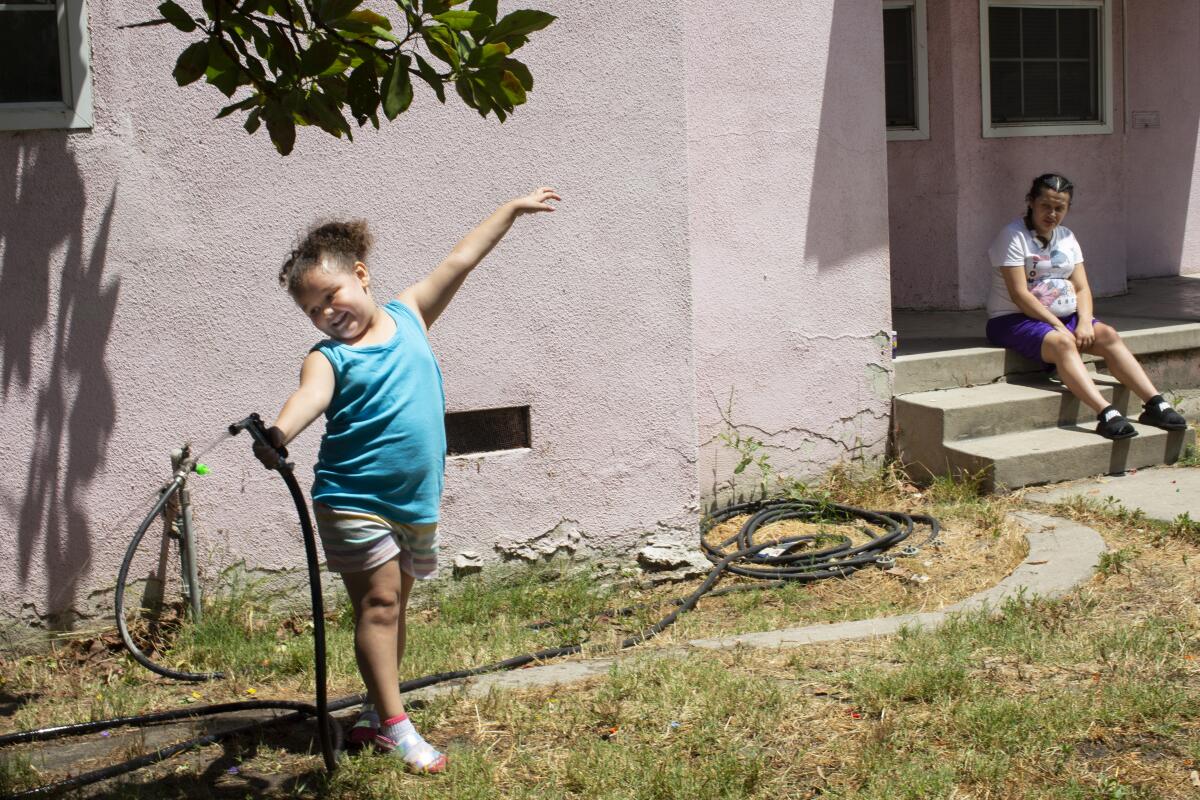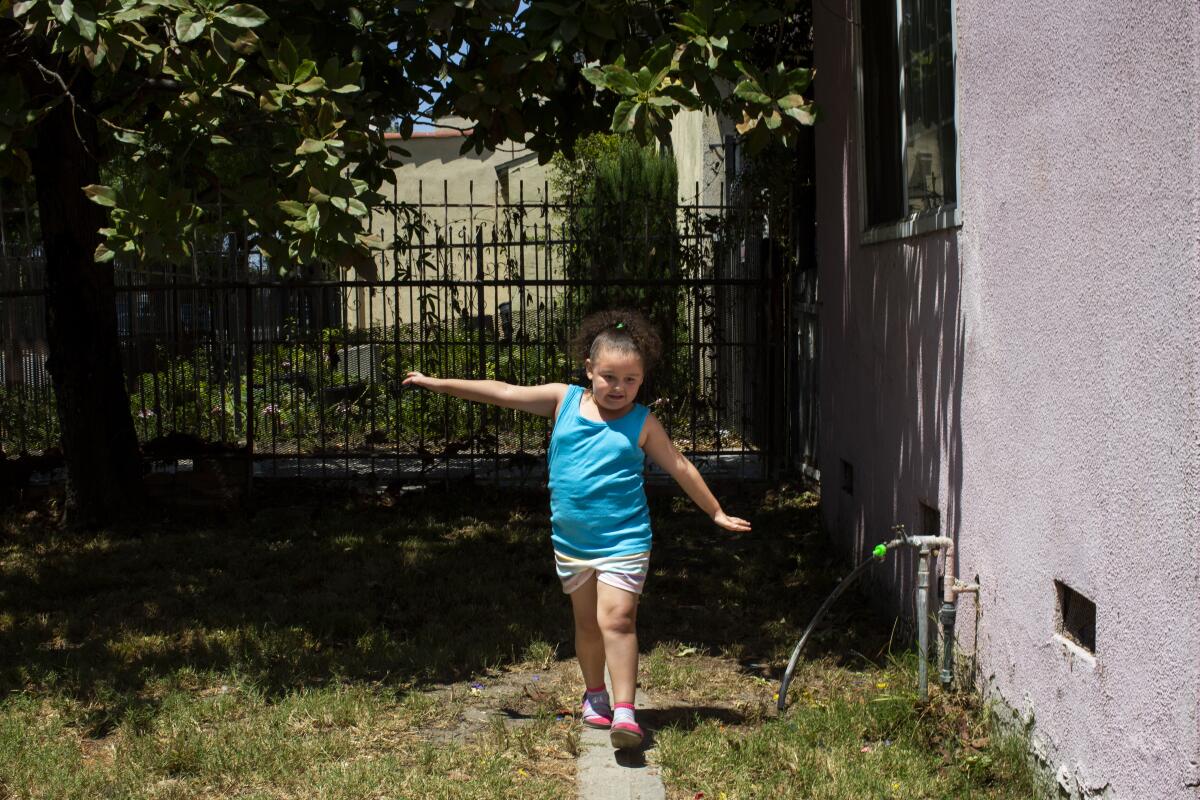Children with disabilities are regressing. How much is distance learning to blame?

Olivia Tan is regressing. She’s lost much of her curiosity, is unwilling to explore her home or flip through books as much as she used to — and her father feels helpless.
The 6-year-old is deaf, blind in one eye and has cognitive delays, heart issues and other physical difficulties that are part of CHARGE syndrome, a disorder caused by a gene mutation. At her Bay Area elementary school, she had a one-on-one aide. At home she has three siblings and two parents trying desperately to offer some semblance of education.
“I don’t feel comfortable doing this,” Simon Tan said of trying to follow the directions of her professional therapists and teachers through a computer. “If somebody asked me just from a standpoint of — are the special education services sufficient? The answer is blatantly no, in no way are they sufficient.”
And Tan knows about these issues. He is a clinical neuropsychologist at Stanford Hospital. Yet like so many California parents, he is overwhelmed by the daily responsibility of carrying out his child’s therapies amid coronavirus-forced school closures.
The education of some 760,000 California children with disabilities has been inconsistent at best since campuses shut down in March. Parents’ worries have intensified as they see their children’s hard-fought advances diminishing — and fear that losses will be compounded with more distance learning ahead, said educators, parents and student advocates.
The state has mandated that school districts continue to provide special education to students with disabilities as required by federal laws, but has waived timelines that allow students to receive assessments and services quickly.
Special education attorneys in California say hundreds of clients, especially economically disadvantaged students and foster youths, overwhelmingly are not receiving the education or services they are entitled to, nor are students who need assessments to receive appropriate care.
“It would be a mistake for anyone to say, ‘Well, we’ve never done this in distance learning before and we’re just not going to do anything at all.’ That goes against everything that we know about the guarantees that students have to receive a free and appropriate education,” State Supt. of Schools Tony Thurmond said.
Yet the personal stories of parents and educators grappling with these responsibilities reveal overwhelming challenges, failed attempts to secure help and, ultimately, the realization that in many cases, the direly needed hands-on services of therapists are not performed well through a computer screen.
“I have spent most of the summer rethinking ... how do we take these evidence-based practices in an online environment? How do we provide equitable access to the families that need it the most?” said Paul Luelmo, a professor of special education at San Diego State. “I wish I had the answers, but I really don’t.”
‘They should pay me for doing the teachers’ job’
In the absence of one-on-one help, parents have become teachers, occupational therapists and speech therapists.
The spring version of Victoria Criswell was optimistic, grateful she had the financial resources and flexibility to be home to support her 16-year-old son Tyler. Well-versed in his needs, she figured a few months of this would be fine. Tyler has CHARGE syndrome and is autistic. He is deaf-blind and has had about 26 procedures to address health and physical challenges.
“I think the district should pay me. They should pay me for doing the teachers’ job because online learning does not work for students with special needs,” Criswell said.
For the last four months Criswell has done little but guide her son via distance learning through all of his therapies — learning how to use his cane, speech therapy, occupational therapy for holding pencils or using the screen, acting as a one-on-one translator — none of which she has formal training to carry out.
“You’ve lost the student in that moment that they might be engaged because you’re sitting there looking up how to sign the word,” she said.
San Ramon Valley Unified School District, where Criswell’s son is a student, is continuing remote learning and remote special education services in the fall for all students but is trying to work with families to address problems, spokesman Christopher George said.
Going backward
Albert Ruvalcaba was excited for his son, Mateo, when he was assigned to a special education teacher at Andrews Elementary School in Whittier. For kindergarten through second grade, Mateo would learn from this instructor, who “really believes in Mateo, she recognizes his potential and how much progress he made throughout the school year and she ... pushes him to get better,” Albert said.
Mateo, 6, has Phelan-McDermid syndrome, a rare genetic condition that for him causes developmental delays and limited fine motor skills. He has difficulty walking and is nonverbal, so he mostly uses a device to communicate his needs. He progressed well during the school year with his teacher and speech, occupational and physical therapists.
Then COVID-19 hit. Mateo’s progress stalled. He hasn’t learned much new vocabulary or tasks, and is not learning new forms of communication, Ruvalcaba said.
The services were inconsistent, his father said. One new online physical therapist seemed unprepared for Mateo’s needs, and made him do lunges and yoga positions that could put him in danger because of his issues with balance, Ruvalcaba said. After a few virtual meetings, the parents stopped the sessions, afraid that Mateo would be injured.
His speech therapy, which he’s entitled to have three times a week for half an hour, was cut to once a week for about 15 minutes, Ruvalcaba said. It improved only in the summer, when a different therapist took over.
Whittier City School District did not respond to a request for comment.
For their part, therapists have had less time to serve children because they had to both undergo training to deliver online services and find new ways to creatively deliver lessons online, said Carol Higa, director of special education for the L.A. County Office of Education.
Educators, too, worry for this class of students.
“We’re so nervous about students coming back and having huge regression,” Higa said. “ How do you recoup that?”
Finding connections
Janette Duran is a counselor at Marlton School in L.A. Unified, which serves deaf students. She understands how cut off some of her students feel — she is deaf herself. The district took weeks to provide captions and sign-language translation for essential online training for teachers, and still not all are available, she said. Meanwhile, some of her students are homeless and many of their family members are not fluent in sign language, leaving them more isolated, she said.
“They become at high risk for becoming depressed and having huge social-emotional impacts,” Duran said. “That’s where some of them are starting to lash out and they start getting frustrated or upset because they’re not able to communicate with their families.”
Data from the Los Angeles Unified School District, which has 64,000 students who require special education services, show that they were disproportionately absent from online learning platforms last spring. Only about half of L.A. Unified’s middle and high school students with disabilities were active once a week on Schoology, one of the district’s primary learning platforms, by late May, according to a district report. That’s about 15 percentage points lower than the rates for students without disabilities.
LAUSD spokeswoman Barbara Jones declined to answer questions about how the nation’s second-largest school district is addressing the needs of its special education students.
In a recorded briefing Monday, Supt. Austin Beutner said students with differences and disabilities are among those “most impacted by the absence of schools and the challenges online learning present.” He said the district is working to improve teacher-student interaction and will move to conduct online assessments when possible.
Never got a chance

Myla Mann was scheduled for an in-person assessment on March 18, days after her Lynwood school closed. Her mother, Andrea Villalobos, has yet to secure an assessment for her 5-year-old, who has trouble expressing her thoughts and communicating.
By the time school starts, her child will have gone without help for six months with no plan in place for her educational needs. Villalobos can’t afford a private assessment.
“It’s just very frustrating,” Villalobos said. “I’m advocating for my daughter’s rights.”
Lynwood Unified School District did not respond to a request for comment.
Many California school districts, at the direction of their public health agencies, have postponed assessments. L.A. County’s 80 districts are not performing in-person assessments, Higa said.
“There’s going to be a backlog,” Luelmo said. But federal law still requires schools to complete assessments, and test makers are working on adjusting them to be done remotely, he said.
“I also understand the point of view of the school district because these assessments must include a variety of tools .... and some of these are hard to do in an online environment.” Luelmo said. “Really at this point we don’t have a good alternative.”
More to Read
Sign up for Essential California
The most important California stories and recommendations in your inbox every morning.
You may occasionally receive promotional content from the Los Angeles Times.











